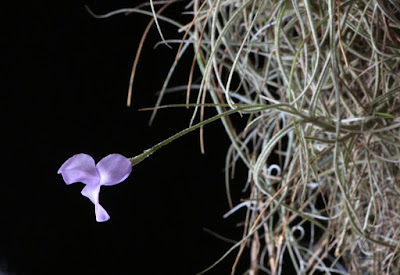Tillandsia mallemontii is native to Brazil. It is found at altitudes ranging from 0 to 1000 meters above sea level. This species, quite variable, can easily be confused with Tillandsia recurvata when it is not in flower.
Tillandsia mallemontii, also called as Phytarrhiza uniflora, is a species of the genus Tillandsia. This species was described by Auguste François Marie Glaziou ex Carl Christian Mez in 1894.
IDENTIFY TILLANDSIA MALLEMONTII AIR PLANT
Tillandsia mallemontii is native to Brazil. It is found at altitudes ranging from 0 to 1000 meters above sea level. This species, quite variable, can easily be confused with Tillandsia recurvata when it is not in flower.
It is a small caulescent with a thin, branched stem, fairly fast growth, which can quickly form clumps and has many, soft leaves inserted along a very fine stem. The sheaths are clearly visible, long and surround the stem. The limbs are more or less curved.
This air plant bloom from the simple inflorescence with a small spike arranged at the end of a smooth, slender peduncle, with couplet flowers. The floral bracts are scaly, often slightly brownish. The fragrant flowers are almost sessile, 1 cm wide, non-tubular, mauve with base and sometimes the middle of white petals. The stamens and pistil are included.
TILLANDSIA MALLEMONTII AIR PLANT CARE AND CULTURE
Cultural information should only be used as a guide, and should be to be adapted to suit you. Your physical location; where you grow your plants, how much time you have to devote to their care, and many other factors, will need to be taken into account. Only then can you decide on the cultural methods that best suit you and your plants.
Light:
Tillandsia mallemontii requires good brightness, avoiding full sun. Place the plant very close to a window indoors in winter and preferably out in mid-shade in the summer.
Temperature:
The required temperature ranging from 10 to 32°C. Get it early enough in the fall if you grow it outside, so that it does not face night temperatures below 7 ° C, especially if it is wet. The plants can faced temperatures close to 0 ° C (sheltered and dry) for a few hours without damage.
Humidity:
This air plant need the moderate to high level of humidity. Good aeration is required, the plant must dry quickly (in less than an hour).
Substrate, growing media and repotting:
Tillandsia mallemontii can be grow suspended or to be mounted on a solid substrate that does not retain water. You can glue the plant directly to the surface with a strong adhesive, or you can wire the plant to the base. Don't cover the base of the plant with moss or it may rot. It can be grown on almost any imaginable decorative mount, including shells, rocks, slate, driftwood, etc.
Watering:
Two or three times a week in summer, one or two times a week in winter according to the luminosity and the ambient humidity. Obviously when it rains and if you grow it outside, it counts as a watering. Some growers prefer the bath to the spray to water this species, especially if the plant is already dense. Watch for leaf tips and increase the frequency of watering if they appear dry.
Fertilizer:
This air plant can be fertilized with the moderate doses. 1 to 2 times a month in the summer and 1 time a month in the winter.

















COMMENTS